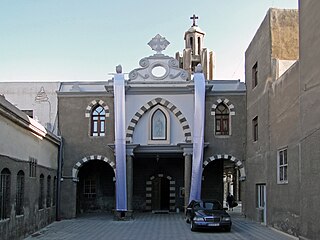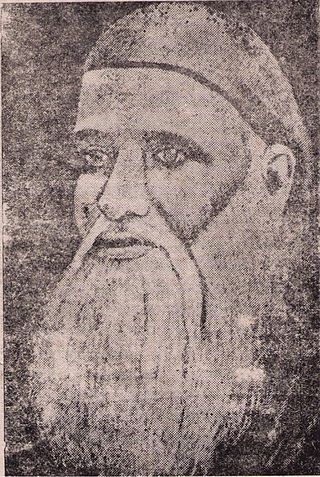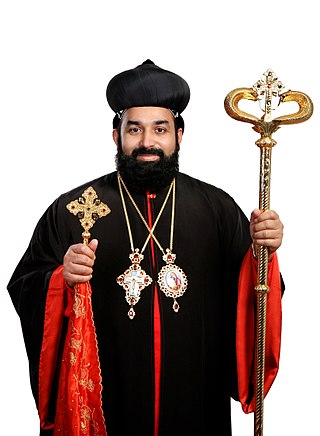This article relies largely or entirely on a single source .(February 2024) |
Mshamshono, pronounced Shamshono, is a rank of deacons in the Syriac Orthodox Church. The word mshamshono means Deacon. [1]

This article relies largely or entirely on a single source .(February 2024) |
Mshamshono, pronounced Shamshono, is a rank of deacons in the Syriac Orthodox Church. The word mshamshono means Deacon. [1]


Ephrem the Syrian, also known as Saint Ephrem, Saint Ephraim, Ephrem of Edessa or Aprem of Nisibis, was a prominent Christian theologian and writer who is revered as one of the most notable hymnographers of Eastern Christianity. He was born in Nisibis, served as a deacon and later lived in Edessa.

The Syriac Orthodox Church, also known as West Syriac Church or West Syrian Church, officially known as the Syriac Orthodox Patriarchate of Antioch and All the East, and informally as the Jacobite Church, is an Oriental Orthodox church that branched from the Church of Antioch. The bishop of Antioch, known as the patriarch, heads the church and possesses apostolic succession through Saint Peter, according to sacred tradition. The church upholds Miaphysite doctrine in Christology, and employs the Liturgy of Saint James, associated with James the Just. Classical Syriac is the official and liturgical language of the church.

The Syriac Catholic Church is an Eastern Catholic Christian jurisdiction originating in the Levant that uses the West Syriac Rite liturgy and has many practices and rites in common with the Syriac Orthodox Church. Being one of the twenty-three Eastern Catholic Churches, the Syriac Catholic Church is a self-governed sui iuris particular church, while it is in full communion with the Holy See and with the entirety of the Roman Catholic Church.

Ignatius Zakka I Iwas was the 122nd reigning Syriac Orthodox Patriarch of Antioch and All the East and, as such, Supreme Head of the Universal Syriac Orthodox Church. Also known by his traditional episcopal name, Severios, he was enthroned as patriarch on 14 September 1980 in St. George's Patriarchal Cathedral in Damascus. He succeeded Ignatius Ya`qub III. As is traditional for the head of the church, Mor Severios adopted the name Ignatius.

An archdeacon is a senior clergy position in the Church of the East, Chaldean Catholic Church, Syriac Orthodox Church, Anglican Communion, St Thomas Christians, Eastern Orthodox churches and some other Christian denominations, above that of most clergy and below a bishop. In the High Middle Ages it was the most senior diocesan position below a bishop in the Catholic Church. An archdeacon is often responsible for administration within an archdeaconry, which is the principal subdivision of the diocese. The Oxford Dictionary of the Christian Church has defined an archdeacon as "A cleric having a defined administrative authority delegated to him by the bishop in the whole or part of the diocese." The office has often been described metaphorically as oculus episcopi, the "bishop's eye".
Gregorios of Parumala, also known as Parumala Thirumeni and Geevarghese Mar Gregorios, was a Metropolitan of the Malankara Church. Parumala Thirumeni became the first person of Indian origin to be canonised as saint. In 1947, the Malankara Orthodox Syrian Church declared Mar Gregorios as a saint, making him the first saint from India canonized by that church. In November 1987, the Syriac Orthodox Church canonized him as a saint.

Mathews Mar Athanasius (Mar Thoma XIII) (25 April 1818 – 16 July 1877) was the Malankara Metropolitan of the Malankara Church from 1852 until 1865. As a reformer, he spent most of his reign attempting to reform and heal rifts within the church. However in 1865, he was deposed by the traditionalist faction of the Malankara Church and Pulikkottil Joseph Dionysius became their leader.

Antiochene Rite also known as Antiochian Rite refers to the family of liturgies originally used by the patriarch of Antioch.

The East Syriac Rite, or East Syrian Rite, is an Eastern Christian liturgical rite that employs the Divine Liturgy of Saints Addai and Mari and utilizes the East Syriac dialect as its liturgical language. It is one of the two main liturgical rites of Syriac Christianity, along with the West Syriac Rite.

Baselios Paulose II (born as Puthusseril Joseph Paulose was the second Maphrian of the Jacobite Syrian Christian Church, which is part of Syriac Orthodox Church.
A chorbishop is a rank of Christian clergy below bishop. The name chorepiscope or chorepiscopus is taken from the Greek χωρεπίσκοπος and means "rural bishop".

Moran Mor Ignatius Jacob (Yaʿqub) III was the 121st Syriac Orthodox Patriarch of Antioch and head of the Syriac Orthodox Church 1957-1980. He was skilled in and knowledgeable in Syriac sacral music or Beth Gazo. He re-established the Maphrianate/Catholicate in the Jacobite Syrian Orthodox Church.

Palakunnathu Abraham Malpan, was an Indian cleric and theologian known for the Reformation movement within the Malankara Church during the 19th century. He was born in the ancient Syrian Christian Palakunnathu family which practiced West Syriac Rite Oriental Orthodoxy after the Coonan Cross Oath of 1653.

The Catholicos of India formerly the Catholicos of the East, is an ecclesiastical office within the Syriac Orthodox Church. He is the Catholicos, spiritual leader and regional head of the Jacobite Syrian Christian Church, an Indian archdiocese of the Syriac Orthodox Church, functioning within the Church at an ecclesiastical-rank second to the Syriac Orthodox Patriarch of Antioch, and his name is commemorated in liturgy throughout the Syriac Orthodox Archdioceses in India. The position was renamed as Catholicos of India in 2002, in accordance with its actual jurisdiction.
Ignatius Behnam Hadloyo was the Patriarch of Antioch and head of the Syriac Orthodox Church from 1445 until his death in 1454.
Ignatius Jacob I, also known as Jacob al-Khuri or Jacob of al-Nabk, was the Patriarch of Antioch and head of the Syriac Orthodox Church from 1510/1512 until his death in 1517/1519.
George Anton Kiraz is a Syriac scholar, best known for his contribution to modern Syriac studies.
Athanasius VI bar Khamoro was the Patriarch of Antioch, and head of the Syriac Orthodox Church from 1091 until his death in 1129.

Ayub Mor Silvanos is a Syriac Orthodox Metropolitan of America, Canada, and Europe region of the Knanaya Archdiocese. He was born on April 18, 1972. He received his first four orders of ordination on November 11, 1995, the fifth order on May 27, 1997, and became a full deacon on June 7, 1999. He was ordained as priest on August 6, 1999, by H. E. Mor Clemis Abraham, the Chief Metropolitan of the East.
Malankara Syriac Knanaya Community are part of the larger Knanaya community who are descendants of an endogamous ethnic migrant group of Syriac-Jewish Christians who arrived and settled in Kerala in the 4th or 8th century.